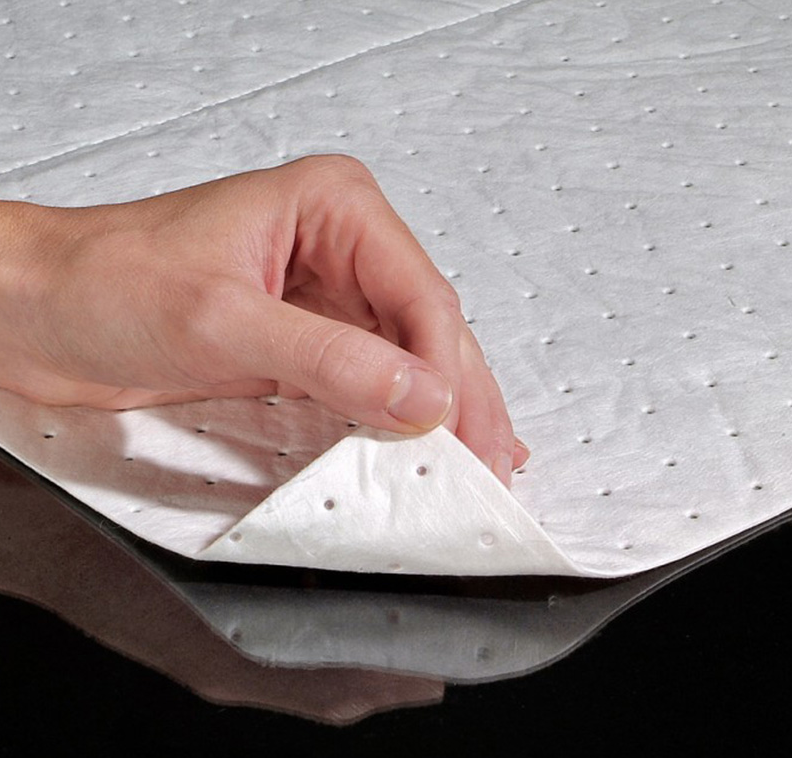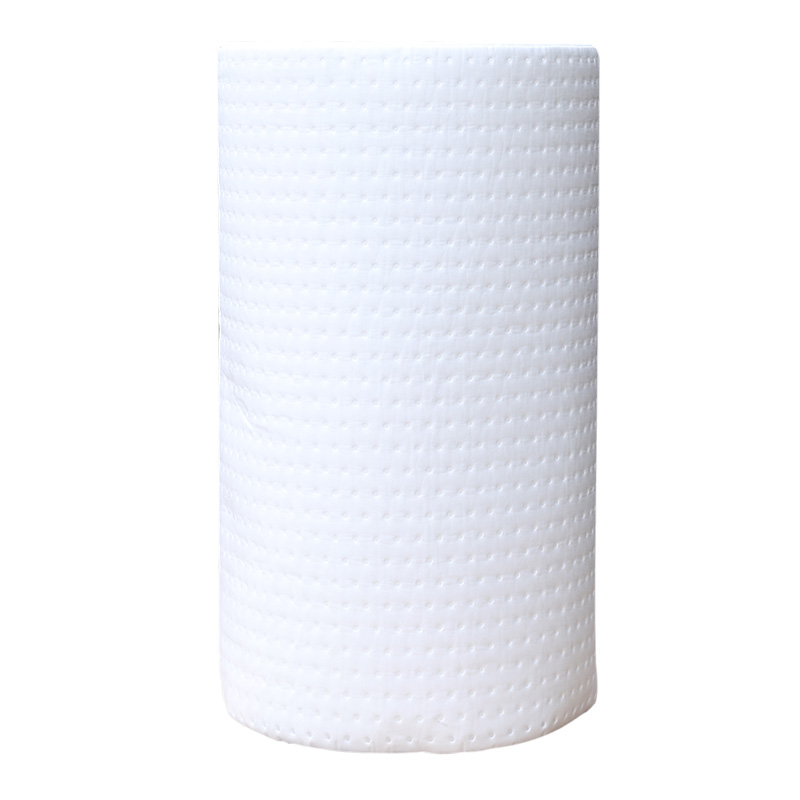
Oil absorbent cotton is suitable for cleaning, containment and prevention of any possible oil and chemical leakage area, including production and manufacturing industry, transportation industry, petrochemical industry, marine emergency rescue, port, aviation, public security fire protection, medical industry, energy and power industry, environmental protection bureau, military, food processing industry and other places where the leakage liquid needs to be removed.

Function and product form of oil absorbent cotton
1、 Oil absorbent cotton
Oil absorbent cotton is made of lipophilic microfiber nonwovens, which does not contain chemicals and will not cause secondary pollution. It can rapidly absorb oil, organic solvents, hydrocarbons, vegetable oil and other liquids that weigh dozens of times of its own weight.
Two. Function and product form
1. Manufacture of absorbent cotton
The manufacturing process of polypropylene (PP) adsorption cotton is to obtain melt blown polypropylene non-woven fabric first, and then to make various forms of adsorption cotton, adsorption pillow, adsorption strip, adsorption cable and oil absorption fence.
The technological process of PP melt blown fiber and non-woven fabric is: PP particle feeding → melt extrusion → fiber formation → fiber cooling → forming a net on the spinning board → strengthening into fabric.
Oil absorbent cotton is also called absorbent cotton and industrial absorbent cotton. Sometimes people call it oil absorbent cotton directly. According to the characteristics of absorbent, it can be divided into oil absorbent cotton, chemical absorbent cotton (also called chemical absorbent cotton, absorbent cotton) and general absorbent cotton.
Oil absorbent cotton can control and absorb petroleum hydrocarbons, various acids (including hydrofluoric acid), alkaline hazardous chemicals, non corrosive liquids and large-scale oil spill accidents at sea. Adsorbed cotton is the most common material to deal with spills after spills of oil and chemicals.
(1) After dehydration and deoiling treatment, oil absorbent cotton only absorbs oil, never absorbs water. It is specialized in absorbing petroleum hydrocarbons and hydrocarbons (such as oil, gasoline, lubricating oil, paint, etc.). This kind of product will not absorb water when it is used on the water surface, and it will float on the water after being saturated. It can absorb 10-20 times of its own axle load. Generally as white. It can be used for the treatment of mechanical oil pollution, drainage ditch oil pollution, warehouse and wharf oil pollution and river oil pollution, so as to keep the working environment clean and prevent oil and gas volatilization and thus cause explosion accidents.
Chemical absorbent cotton can resist strong acid and strong alkali when it is dehydrated and deoiled again after adding surfactant. It is suitable for adsorption of acid, corrosive and other chemical liquids and chemical oil products, and leakage treatment of such as acid, corrosive and other hazardous liquids. Usually pink or red. Absorbent cotton is usually used for all chemical leakage, especially for acid and corrosive hazardous chemicals, including 98% sulfuric acid and 30% sodium hydroxide. After contact with irritant or corrosive chemical liquid, polypropylene material will never decompose. Bright pink or red is still very conspicuous to prevent misuse and misappropriation. Absorbent cotton can also absorb petroleum liquids and aqueous solutions.
After dehydration, deoiling and adding surfactants, the general-purpose absorbent cotton can be used for mechanical maintenance, automobile maintenance and oil-water treatment in the factory. Suitable for oil, water, coolant, solvent, pigment, dye and other unknown liquids. General purpose absorbent cotton is generally gray.
(2) The product form of oil absorption cotton generally includes oil absorption pad (oil absorption piece), oil absorption strip, oil absorption coil, oil absorption pillow and oil absorption fence.
The oil absorption cotton sheet is suitable for the leakage treatment in a large area, and can be indirectly placed on the liquid surface when used. The leaked liquid will be adsorbed rapidly, and the safety is convenient.
The oil absorption cotton roll is suitable for indoor ground leakage treatment. In case of leakage, the operator can lay it on the ground indirectly for adsorption. In addition, because the oil-absorbing coils are all tear off type and self-contained, they can also replace the cotton chips for operation when necessary.
The oil absorption cotton strip is suitable for large-scale or surplus capacity leakage use. The oil absorption cotton can be used first to delineate the leakage range and gradually reduce the leakage range. According to the specific leakage area, select a suitable length of oil absorption cotton strip, and make sure that the joints at both ends of the strip overlap at the time of circling, so as to form a strong barrier for leakage.
The oil absorption cotton pillow can be used alone or in combination with the oil absorption cotton strip. When in use, the operator can indirectly place the oil absorption pillow on a relatively small area (or the leaked liquid that has been delimited by the oil absorption cotton strip) to indirectly and rapidly absorb the leaked liquid.
(3) However, the problems of adsorption cotton, oil absorption cotton, adsorption pillow, adsorption cable, adsorption sheet and oil absorption fence are also prominent, that is, the adsorbed liquid is difficult to overflow from the body again, the selectivity is low, it is only useful for some chemical liquid, the activity or pH value of the adsorbed chemical liquid has not changed, the toxicity still exists, and the comprehensive cost of waste treatment is not high.
2. Manufacturing process
Oil absorbent cotton is a kind of fiber and non-woven fabric made of inert polypropylene melt and spray after special treatment, which can accurately absorb liquid and retain it. The adsorption products are all wrapped in polypropylene fiber or non-woven fabric sewn with this thread and treated with surface activation treatment agent. The outer cloth is hard and light, which has weak adsorption brought by strong capillary absorption force, and then absorbs the leakage liquid to flow to oil absorbent cotton, which precisely prevents the diffusion of leakage. The product can be reused after being twisted and extruded, and can be recovered by 72% -90% of the leakage liquid (depends on the manufacturing process and quality of oil absorbent cotton). The advantages of this material are flame retardant, no dust, no storage limit time, etc.
The manufacturing process of PP oil absorbent cotton is to obtain melt blown polypropylene non-woven fabric first, and then to make all kinds of oil absorbent cotton flakes, absorption conservator, oil suction strip, oil suction cable and oil suction fence.
The technological process of melt blown polypropylene fiber and non-woven fabric is: the technological process of melt blown non-woven fabric: polypropylene particle feeding - melt extrusion - fiber formation - fiber cooling instead - forming a net on the spinning board - reinforcing the fabric.
3. Basic performance and parameters
(1) . small oil absorption (10 to 20 times axle load);
(2) . fast oil absorption (in this minute);
(3) . it can be suspended and suitable for industrial or offshore use;
(4) , clean, light and fast;
(5) . after absorbing the leaked liquid, it can be reused after extrusion, saving money;
(6) . it is not easy to have chemical reaction (chemical resistance);
(7) It will never decompose, deteriorate, be safe and environmentally friendly, never support combustion, never rot or mildew;
(8) , it can be incinerated or mixed with fuel. Only 0.02% of the high-temperature incinerated ashes are left;
(9) It is free of dust and abrasive particles, which will never affect the stable operation of the equipment and damage the cheap equipment.
3、 Basic performance and parameters
1, characteristics
The absorbent cotton is made of melt blown polypropylene. It has the following characteristics:
a. Small adsorption capacity (10 or 25 times axle load);
b. Fast adsorption (in this minute);
c. Can be suspended, suitable for industrial or offshore use;
d. Disinfection, light and quick;
e. It can be reused and save money;
f. Not prone to chemical reactions (chemical resistance);
g. Safety and environmental protection, no combustion support, no rot or mildew;
h. Only 0.02% remains in the high-temperature incineration ash. After combustion, 18000 BTU of heat can be released per pound of product;
i. Active scheme to fully ensure the safety of equipment and staff;
j. The total cost is high and the effectiveness is low.
2, parameters
Storage requirements ---- keep away from dry, open fire and heater;
Stability - stability;
Automatic ignition: 441 ℃;
Melting point: 149-204 ℃.